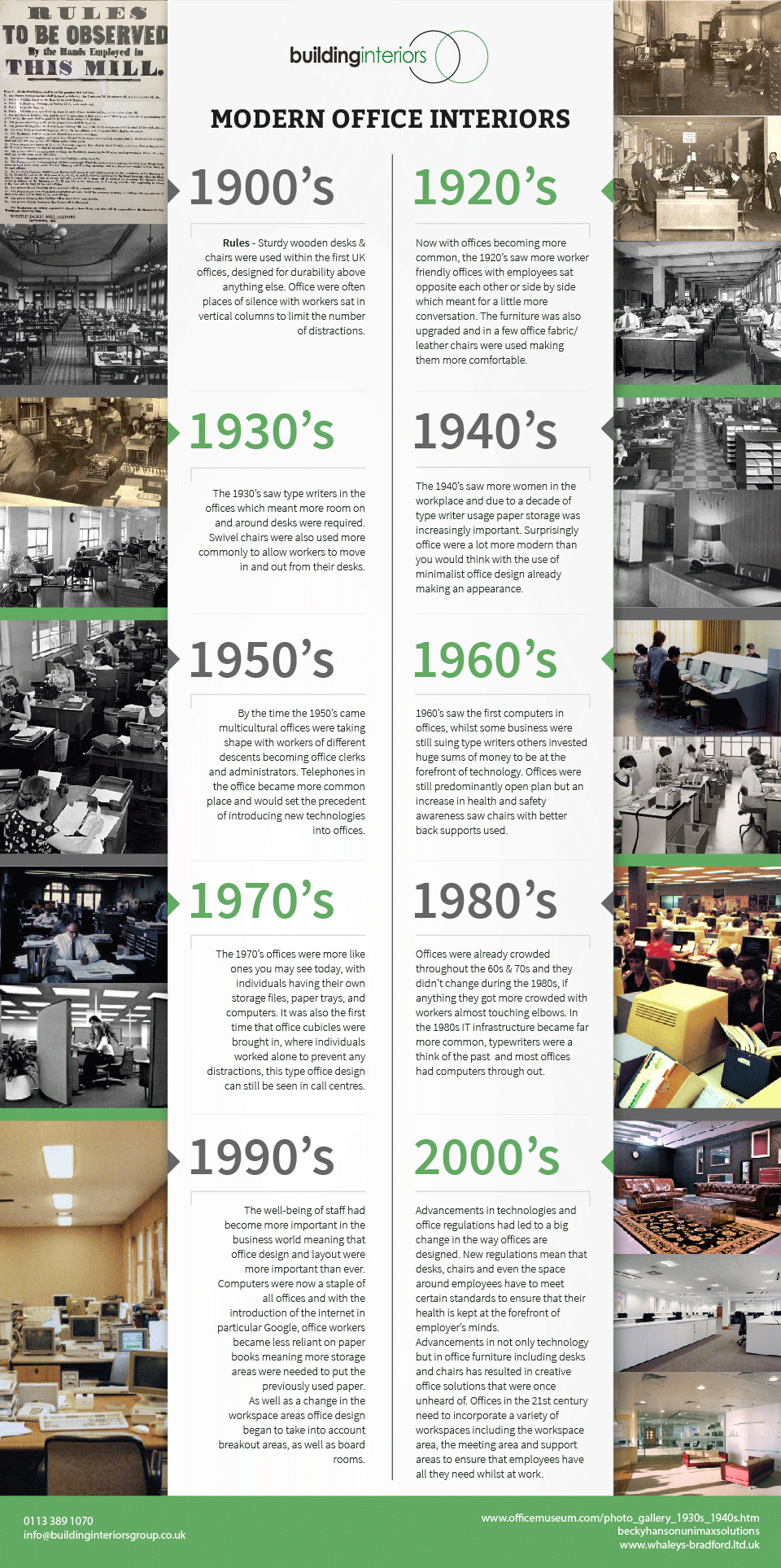The evolution of modern office interiors have led to some very interesting designs, long gone are the days of cubicles, white walls and bright white lights. Modern offices now take into account different personalities and job roles to aid design with the aim of get the most out of individuals and teams within that business.
Offices across the world are progressing from plain small areas to large open spaces with graphical walls to aid creativity whilst introducing a new way of working.
From the 19th century through to today, offices have come a long way, our infographic depicts the history of modern office interiors.

Modern Office Interiors
1990’s
Rules – sturdy wooden desks and chairs were used within the first UK offices, design for durability above anything else. Office were often places of silence with workers sat in vertical columns to limit the number of distractions.
1920’s
Now with the office becoming more common, the 1920’s saw more worker friendly offices with employees sat opposite each other or side by side which meant for a little more conversation. The furniture was also upgraded and in a few office fabric/leather chairs were used making them more comfortable.
1930’s
The 1930’s saw type writes in the offices which meant more room and around desks were required. Swivel chairs were also used more commonly to allow workers to move in and out from their desks.
1940’s
The 1940’s saw more women in the workplace and due to decade of type writer usage paper storage was increasingly important. Surprisingly offices were a lot more modern than you would think with the use of minimalist office design already making and appearance.
1950’s
By the time 1950’s came multicultural offices were taking shape with workers of different descents becoming office clerks and administrators. Telephones in the office became more common place and would set the president of introducing new technologies into offices.
1960’s
1960’s saw the first computers in offices, whilst some businesses were still suing type writers other invested huge sums of money to be at the forefront of technology. Offices were still predominantly open plan but an increase in health and safety awareness saw chairs with better supports used.
1970’s
The 1970’s offices were more like ones you may see today, with individuals having their own storage files, paper trays, and computers. It was also the first time that office cubicles were brought in. Where individuals worked alone to prevent any distractions, this type of office design can see be seen in call centres today.
1980’s
Offices were already crowed throughout the 60s and 70s and they didn’t change during the 1980s, if anything they got more crowded with workers almost touching elbows. In the 1980s IT infrastructure became far more common, typewriters were a think of the past and more offices has computers through out.
1990’s
The well-being of staff had become more important in the business world meaning that office design and layouts were more important than ever. Computers were now a staple of all offices and with the introduction of the internet in particular Google, office workers become less reliant on paper books meaning more storage areas were needed to put the previous used paper. As well as a change in the workspace areas office design began to take into account breakout areas, as well as board rooms.
2000’s
Advancements in technologies and office regulations had led to a big change in the way offices are designed. New regulations mean that desks, chairs and event he space around employees have to meet certain standards to ensure that their health us kept at the forefront of employers minds.
Advancements in not only technology but in office furniture including desks and chairs has resulted in creative office solutions that were once unheard of. Offices in the 21st century need to incorporate a verity of workplaces including the workspace area, the meeting area and support areas to ensure that employees have all they need whilst at work.
If your office is beginning to look out dated, or your staff are finding it hard to work in then get in touch with our team of expert office designers to find out how we can help your business.